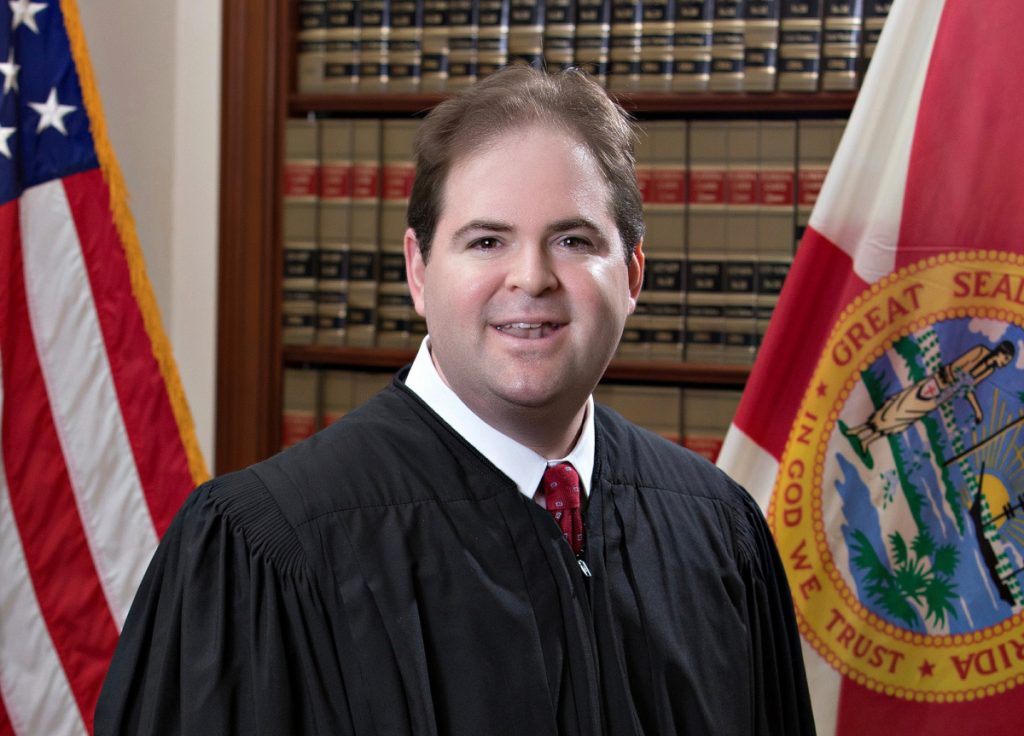By Kristin A. Norse, of Kynes, Markman & Felman, P.A.

In January of this year, Governor Ron DeSantis appointed the Honorable Robert J. Luck to be the 88th justice of the Florida Supreme Court, filling one of three vacancies left at the end of 2018 by the retirements of Justices Barbara Pariente, Fred Lewis, and Peggy Quince. At the time of his appointment, The Record had only recently published a Judicial Profile of Justice Luck covering his background and experience leading up to his appointment and service on the Third District Court of Appeal. For those seeking to learn more about Justice Luck the person, you can find that article here. Having thoroughly delved into those matters but hoping to commemorate his elevation to the Florida Supreme Court, the Section asked Justice Luck if he would be willing to answer a few more in-depth questions about how his prior experiences and interests shape his perspective and approach as a justice. He graciously agreed to do so.
Congratulations on your appointment! Now that you have served as a justice for a few months, was there anything about your new position that surprised you or that you didn’t expect?
There is something that was not personally surprising to me, but that I find others—even judges and attorneys—find surprising, and that is the amount of work the Florida Supreme Court does that is not the traditionally well-known task of resolving cases. When most people think of the work of the Florida Supreme Court, they think of work similar to what the United States Supreme Court does, reviewing briefs, holding oral argument, issuing written decisions. But the Florida Supreme Court is also the head of The Florida Bar and the Judicial Branch. One of its largest dockets is the one involving disciplinary proceedings for lawyers and judges. And then there are the policy making and rule making tasks the Court does, each policy and rule requiring careful consideration.
When I try to explain it to others, I describe the Court as wearing three hats. The first is the one you see on television or other media, deciding cases. The second is overseeing the Bar, with its more than 100,000 lawyers across the country. And the third is overseeing the branch, including over 600 judges and thousands of employees. Each role takes a tremendous amount of time and thought.
You previously clerked for an Eleventh Circuit judge, the Honorable Ed Carnes, and worked as a federal prosecutor. Then you served as a circuit court, then a district court judge, and now serve as a justice in the Florida state court system. What are some of the biggest differences you see between the federal courts and the state courts?
One of the biggest differences between the federal and state judicial systems are the resources available to the judiciary. At the appellate level, for example, 11th circuit judges have four law clerks and a staff attorney, and then there is a central staff with 50 to 70 attorneys. We do not have the same resources in the state appellate system.
At the trial level, federal district court judges have 2-3 law clerks. But state circuit or county court judges are not assigned individual law clerks, and rely instead on access to a law clerk who works for a group of judges.
Another significant difference between the two systems is how cases are processed at the trial level—both in criminal and civil cases. Federal criminal prosecutions are proactive. There is typically a thorough investigation made before any arrest. Once the arrest is made, the case can progress relatively quickly because the groundwork is already laid. The state criminal system is more reactive. Arrests may be made early in a case and then a more thorough investigation ensues as part of the criminal prosecution process.
On the civil side, there is also a difference in how the litigation process works. In the federal system, the judiciary drives the litigation schedule. Once a case is filed, a scheduling order is issued that sets the course and schedule for the case and triggers deadlines. Litigants are required to comply or actively seek extensions.
In the state system, the attorneys and litigants are primarily responsible for moving the case forward. They have to file the motions and schedule the hearings that move the case forward.
In this respect, it’s striking to me that you can have two courts blocks away from each other that operate so differently.
There are advantages and disadvantages to each system, depending on the circumstances. I think you’ll hear praise or complaints regarding both. In a federal case, the court-imposed structure may push a case forward more quickly even when the litigants may need additional time or the subject matter might ideally merit it. In the state system, there can be frustrating delays when lawyers or litigants struggle to move a case forward. In the end, both systems can learn from each other.
Your experience has also spanned both civil and criminal practice. Which do you find more interesting, or what aspects of each do you find most compelling?
I find both areas of law interesting and don’t prefer one over the other. And there are things I find compelling in both.
I find civil litigation compelling and interesting because of its diversity—it covers a lot of ground. For those who remember looking at the shelves of books, Florida Jurisprudence used to span about 60 volumes, and of those 45 to 50 involved civil litigation, with only 10 to 15 addressing criminal law. When I was assigned to a circuit civil division, it was not unusual to find myself presiding over a case that involved a cause of action or statute I had never previously heard of.
Criminal law is compelling to me because every criminal case implicates individual liberties and governmental power.
You also have the experience of serving in all three branches of government. Has that given you any unique insights into your role as an appellate jurist?
Having the opportunity to work in each branch of government—for me, having worked in the executive branch with the Department of Justice and in the legislative branch as a legislative aid for two senators on Capitol Hill—has given me a greater understanding and respect for the role that each branch plays in our system of government. But this experience is not unique to me. Chief Justice Canady and Justice Muniz, for example, have also worked in the executive and legislative branches.
I would assume one of the biggest differences between your position as a district court judge and your position as a justice is that now you are considering each case with six of your colleagues, not two. How does that change the dynamics of the decision-making process? Do you approach oral argument differently? Do you approach your discussions with the other justices differently than you did when you were trying to persuade other district court judges of your position?
The goal in both cases is the same—we are trying to find the right answer. That means the approach is generally the same. The dynamics are different only in that conferences are a bit longer with seven justices rather than three judges. But the greater number means there are more bright minds in the room, and I believe that helps lead to a better result, particularly when you are talking about cases with statewide application.
My preparation for oral argument is the same. But with more justices asking questions, it can be harder to jump in with the questions you want to ask. So I find myself being a bit quieter on the bench in a typical oral argument, and perhaps prioritizing the questions I want to ask.
One interesting distinction is the way conferences are conducted. At the Florida Supreme Court, the primary Justice speaks first and then each justice speaks in the order of seniority. As a result, because I’m the second-most junior justice, there is not always a lot for me to add or say by the time the discussion reaches me. At the Third District Court of Appeal, the general practice was to have the primary judge speak first and then the other judges spoke in reverse order of seniority. That meant I was often offering my opinion or insights in a case before my colleagues.
That brings up another question appellate practitioners may be interested in. How is the primary justice selected for each case?
As in the district courts of appeal, a primary judge is selected at random before oral arguments are scheduled and in a manner that each justice is assigned the same number of cases.
Do you think you will have a different approach to your work philosophically as a justice than you did as district court judge? For example, does the fact that your decisions will have statewide impact affect how you approach them or think about them?
I don’t think there’s a different approach philosophically. Again, the goal is the same—to get it right. But the task is different. A number of district court cases involve “error correction.” The opinion describes the law and how it should have been applied to a particular set of facts. In the supreme court, the task in resolving cases often involves sorting out conflicts in the law or addressing questions of great public importance. The conflict cases and those presenting unresolved issues of great public importance provide an appreciably different task than the cases typically decided by a district court of appeal.
One distinction between the supreme court and the district court, of course, is the more limited jurisdiction and the necessity of deciding on a regular basis when it is proper to exercise jurisdiction when it is discretionary. What factors go into that discretionary decision on jurisdiction? What are you looking for in deciding which cases merit further review?
Much has been written in the case law on this topic, and there is not much more to add. But the numbers do tell a story. Historically the supreme court has taken up to 90% of cases in which a district court has certified conflict or a question of great public importance. I think that speaks to the deference the supreme court affords to district court judges and the priority the Court places on assisting district court judges who are struggling to answer difficult and important questions and seeking guidance from the court.
In your prior profile article, you mentioned enjoying reading historical biographies. What historical figure most intrigues you? What period of history is of the most interest to you?
The “most intriguing historical figure” is one of those impossible questions, because it is so difficult to pick one. But as I am asked to choose, I would have to say George Washington. At the time of his presidency, it was outside anyone’s experience that a person as revered and powerful, entrusted to run a country he himself had helped create, would willingly cede that power and position to effectively become a gentleman farmer. He did it for the good of the country, to set that important precedent. During the difficult winter at Valley Forge, and in the difficult years before and after, he held the army together until France could provide assistance. I’m not sure there are many people throughout history who could have accomplished what George Washington did or make a similar mark.
I am currently working my way through the history of the Florida Supreme Court, reading now the third volume of the compendium prepared by the Florida Supreme Court Historical Society. The book is extremely well researched and I recommend it to anyone who is interested in the court.
Another way in which you have been able to experience both sides of a coin is that you had the experience of both running for election and appointment. What are your thoughts on both processes?
This is another area where I can see the advantages of both selection processes. There are great judges across the state who are serving through each of these processes.
It’s interesting to note that Florida voters have been asked numerous times if they want to switch away from the election of judges to a system of pure appointment, but the voters consistently say no.
As for my own experience, running for election required me to go into the community and meet citizens and leaders I would not have otherwise met. It allowed me to see places I may not have otherwise seen. That made me a better judge and a better person.
What do you think is one of the biggest challenges facing the legal system today?
As a justice of only a few months, it may be harder to answer that question. But one of the biggest challenges we face is access to justice—solving the problem of providing legal services to underserved or unserved populations. How do we ensure everyone who needs a lawyer has access to one? How do we ensure lawyers can provide services to all of the citizens that need them? This is a problem that is the subject of discussion and action by the Access to Justice Commission, The Florida Bar Pro Bono Committee, and the Florida Bar Foundation, as well as many local legal aid societies and local bar associations. It is a discussion we may need to continue for years to come.
On a more personal note, do you think being a parent has changed the way you think about some of the cases that come before you?
It hasn’t changed the way I look at cases. But I do believe being a parent has made me a better person and a better judge. It has taught me to be more patient, and to be a better listener and communicator. And it has changed my life priorities. Being a parent has certainly heightened my desire to serve, and to leave the state in as good or better a place for my children and others.
Achieving appointment as a Florida Supreme Court Justice is really a pretty high pinnacle when it comes to career goals. Having accomplished that, what remaining goals do you see for yourself?
My main goal is to tackle this job and to do it well. During my interviews with the Judicial Nominating Commission, I was asked a question along the lines of what judge or justice I most admired. When I think of the many justices that have served, one that comes immediately to mind is Justice Arthur England, who I had the honor of working with at Greenberg Traurig. He joined the supreme court at a time of great turbulence for the Court. He helped right the ship and turn it into the fine institution it is and has been. He was such an agent for positive reform for the judiciary and the practice of law—spearheading the revision of Article V, helping to institute the IOTA system with its benefits to legal services, reforming tax and administrative law, etc. If I can be half the person and justice that he was, I’ll feel that I’ve done a job worthy of the position.
Thank you so much for your time and your willingness to share your views with our members.
 Kristin Norse is a partner at Kynes, Markman & Felman, P.A., where she practices exclusively in the areas of appellate practice, litigation support, and trial consulting in state and federal courts. Ms. Norse has over 20 years of experience in appellate practice. She received her juris doctorate degree from Boston University School of Law, and has a Bachelor of Arts Degree in English, cum laude, from Boston University’s College of Arts and Sciences. After law school, she joined Hampton, Stoddard, Griffin & Runnells, P.A., and later worked with the firm of Harris, Barrett, Mann & Dew, P.A. After seven years in private practice, Ms. Norse became a senior staff attorney for the Honorable Chris W. Altenbernd at the Second District Court of Appeal. She remained in that position until joining Kynes, Markman & Felman, P.A. Ms. Norse currently serves on the Rules of Judicial Administration Committee. She is a past Chair of the Appellate Court Rules Committee and the Appellate Practice Section. She is also a past president of the Florida Association for Women Lawyers and the Hillsborough Association for Women Lawyers. She previously served on The Florida Bar’s Citizen’s Advisory Council as a lawyer member, and on the Special Committee on Gender Bias.
Kristin Norse is a partner at Kynes, Markman & Felman, P.A., where she practices exclusively in the areas of appellate practice, litigation support, and trial consulting in state and federal courts. Ms. Norse has over 20 years of experience in appellate practice. She received her juris doctorate degree from Boston University School of Law, and has a Bachelor of Arts Degree in English, cum laude, from Boston University’s College of Arts and Sciences. After law school, she joined Hampton, Stoddard, Griffin & Runnells, P.A., and later worked with the firm of Harris, Barrett, Mann & Dew, P.A. After seven years in private practice, Ms. Norse became a senior staff attorney for the Honorable Chris W. Altenbernd at the Second District Court of Appeal. She remained in that position until joining Kynes, Markman & Felman, P.A. Ms. Norse currently serves on the Rules of Judicial Administration Committee. She is a past Chair of the Appellate Court Rules Committee and the Appellate Practice Section. She is also a past president of the Florida Association for Women Lawyers and the Hillsborough Association for Women Lawyers. She previously served on The Florida Bar’s Citizen’s Advisory Council as a lawyer member, and on the Special Committee on Gender Bias.


